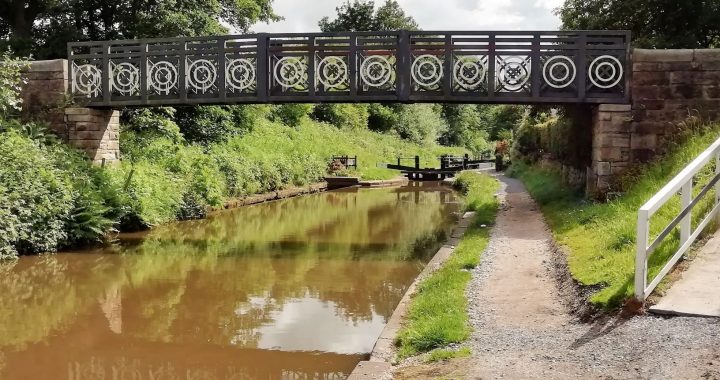Back On Board
Having returned to the boat in Stoke On Trent on Tuesday afternoon we didn’t plan to take it very far. Two miles north of the marina there is a large expanse of water managed as a wildlife and bird watching centre called Westport Lake that sits right beside the Trent & Mersey Canal. There is a long stretch of two day mooring here that provides a convenient stop just short of the Harecastle Tunnel, which is quite a feature in itself.
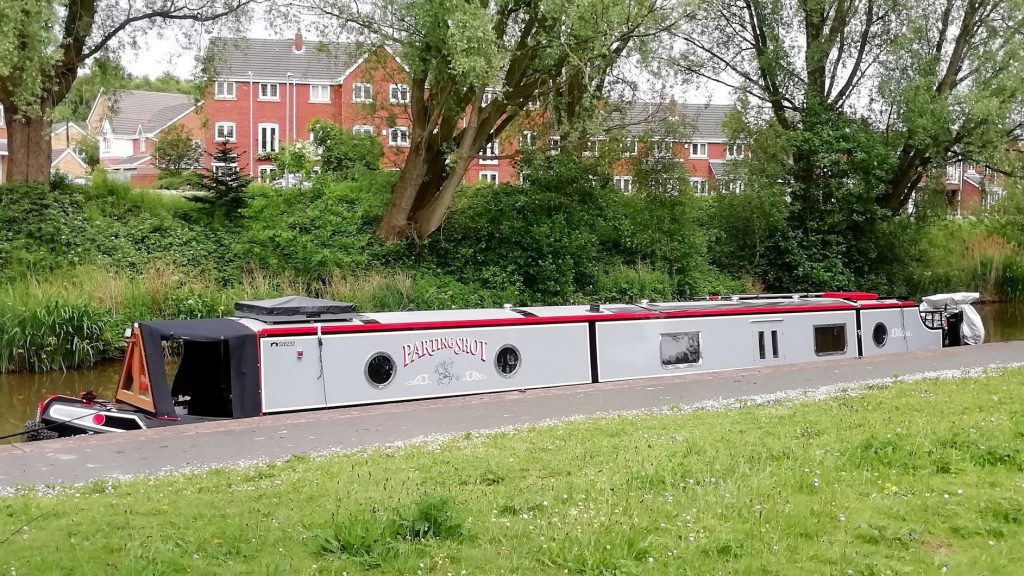
Set aside as a leisure area by a local farmer as long ago as 1890, the lakes apparently descended into wasteland before being reinstated in the mid 1980s. It seems a bit of a shame that the new housing development has then been built right opposite and looming above it. There is a big Visitor Centre and café, in the base of which is a CRT service area with showers, toilets, a sanitary station etc. Given that level of investment, the lack of a water point on the mooring seems rather a strange omission.
On our trip south we had picked up a list of things to complete little jobs around the boat and we stayed on here on Wednesday to get some of those done. Walking Bracken down to the start of the tunnel and having a look at what we would be facing the next day was sufficient procrastination to ensure that some rain had arrived and forced us to focus on jobs inside to start with. As it brightened up a bit later we managed to dry out the bilges from all the rain that had accumulated in the last couple of weeks and cleared the drainage channels that may have contributed.
Harecastle Tunnel & Beyond
We set out on Thursday to negotiate the Harecastle Tunnel and then turn off on to the Macclesfield Canal. The Harecastle Tunnel is not the longest on the network but is over one and a half miles long and only accommodates one-way traffic. The height of the tunnel varies considerably along its length but at its lowest can be less than seven feet at the sides. That also varies depending on the depth of the water at any given time. No ventilation shafts were built into the tunnel originally as the boats had no engines but now there are huge fans which start up as you enter, to ensure that diesel fumes do not overcome the helmsman or the crew passing through. Doors close across the southern portal to ensure the fans are effective as well as to prevent unauthorised entry. Of course, you can’t just turn up and drive on through. The traffic is managed by CRT tunnel keepers who inspect the boats arriving to make passage, provide safety briefings to their crews and check that nothing on the boat touches the gauge suspended from the main tunnel entrance. With an average transit time of forty minutes you don’t want to just miss the last set of boats allowed in or you’ll be waiting an hour and a half to be allowed through.
Thursday having been trailed as a fine, dry day offered a grey start with light rain as we set out. We thought we would fill up a water point at the tunnel entrance, on the opposite bank to the queue, while waiting to be allowed in. In the event, having set our course to glide in to the left bank, we realised that the doors were open, so boats must be about to emerge. That meant we didn’t have time to water up and should really be in the queue on the right bank and a couple of lengths behind us. As with any sudden change of plan, farce ensued. The rain intensified accompanied by strong winds that disrupted the attempt to reverse smoothly back up and move across the canal. The lead boat appeared from the tunnel far too soon to find us sideways across the cut and their crew were clearly wondering what we were up to. They could stop, of course. However, behind them in the darkness of the tunnel would be a handful of other boats with no idea that there was an issue. We did manage to sort ourselves out fairly quickly, clear the passage and get in line for inspection but it was an entertaining few moments for all concerned.
Air draft is one statistic not included in the specifications the builders provided se we had wondered whether our top box might give us a problem with the height. In fact we were well clear of the gauge as we entered the portal and the only thing that didn’t clear it were my head and shoulders. At first the tunnel seemed to be a more comfortable size than expected but the lowest sections are from near the middle onward. Sure enough I could just see the roof coming down to meet me and ended up crouched down on the rear deck trying to steer completely blind with only six inches clearance on either side. Still, we made it through without incident and emerged into a slightly brighter and drier daylight than we had left forty minutes before.
Beyond the tunnel, at Kidsgrove, the Trent & Mersey continues North West while a junction provides access to the Macclesfield Canal, which heads off North East to Macclesfield and Marple. Given this description it may seem surprising that we had to turn left at this junction. Apparently, when the upstart Macclesfield was approved to be built, the owners of the Trent & Mersey insisted on building and retaining control of the first one and a half mile stretch of water to meet it. The channel takes a convoluted route to turn sharp left, then sharp right to run parallel to the course of the original canal and sharp right again to cross it via an aqueduct, the Trent & Mersey having, by that time, dropped down to a lower level via a flight of locks. Apparently this is one of only two flyover junctions on the network, so we assume the other must be the junction with the Leek arm that we encountered on the Caldon Canal a couple of weeks earlier.
As we entered the Macclesfield there was quite a different feel. Suddenly the banks were overgrown with lush vegetation and the trees hung close over the channel. Everything was wet but the sun was shining now and the birds were celebrating. All in all it felt a little as though you were travelling up the Amazon in an oversized dugout. Despite plenty of reminders of the different industries it served, the cotton mills, silk mills, coal mines and stone quarries, our overall impression of this canal is that it is prettier and a lot more rural than we had expected. The bridges are attractive features like these at Hall Green and Congleton:

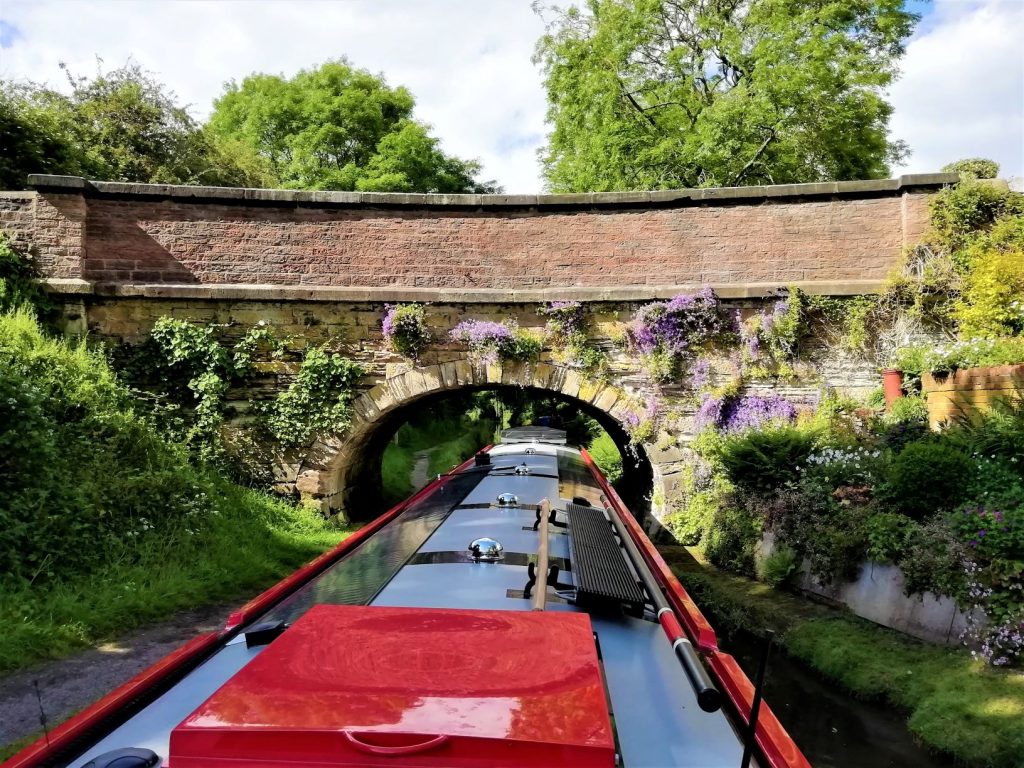
The milestones along its length, badly weathered now, are quite distinctive and show the distance from Marple on one side and Hall Green on the other. Apparently, during the war, they were removed and buried to confuse enemy paratroopers. When the canal was being restored The Macclesfield Canal Society found and reinstated as many as they could and had replicas made for the missing ones.
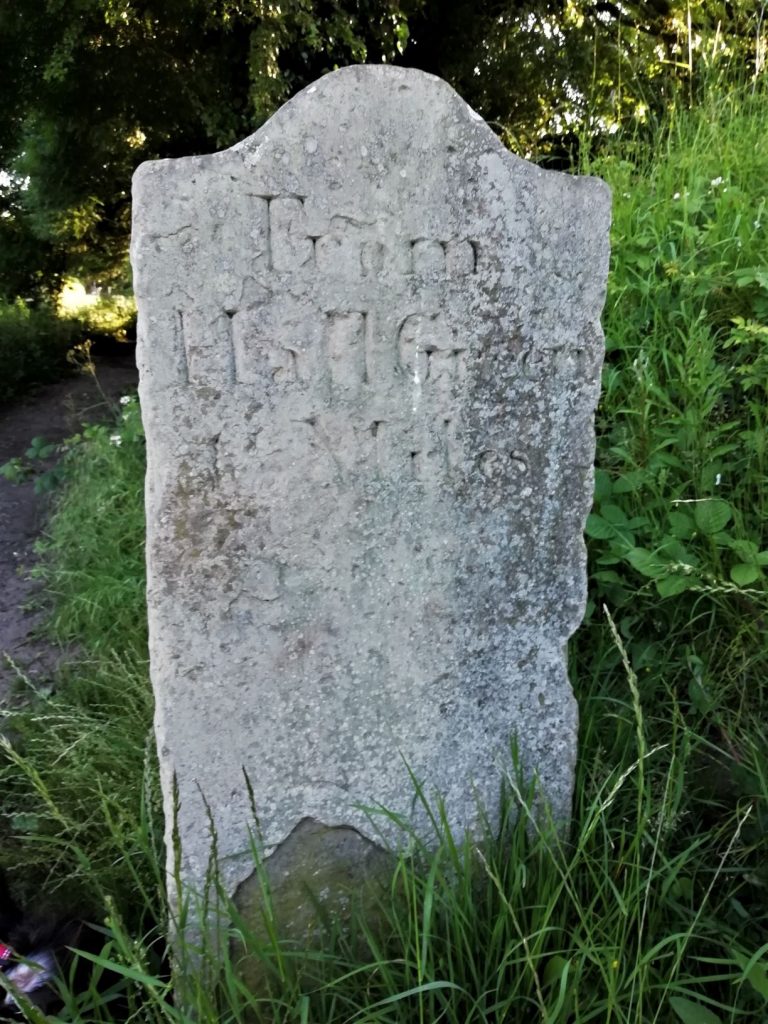
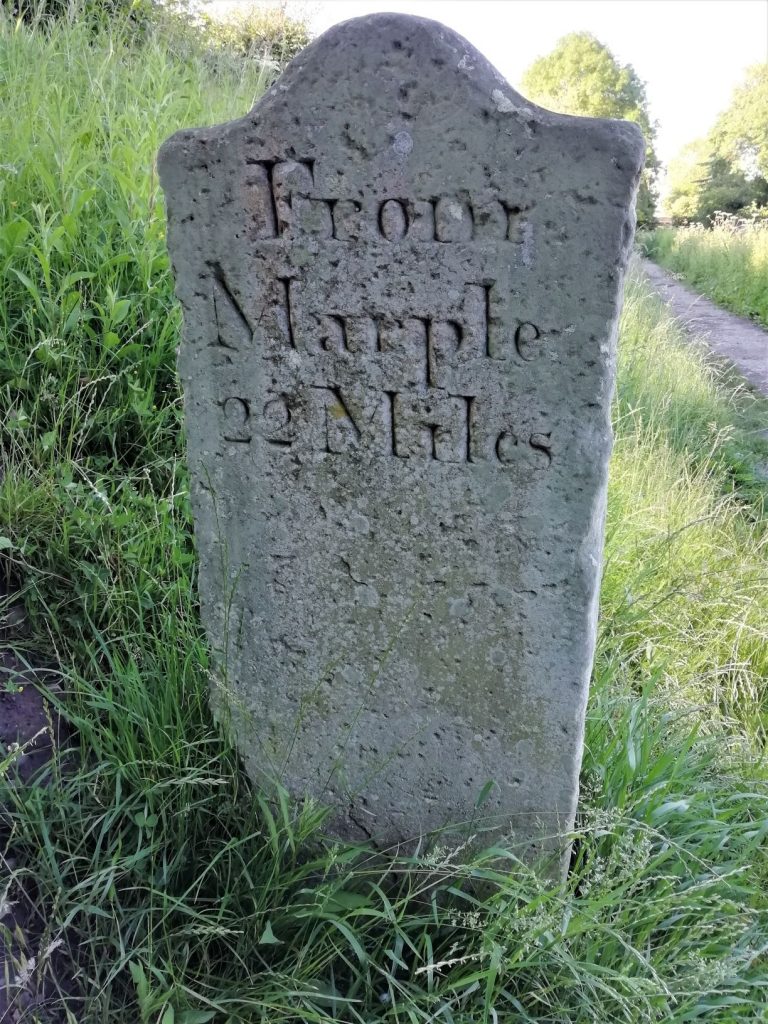
The banks continued to be very green and overgrown wherever there was no specific mooring and we were often switching between open country and deep woods all along its length. We were travelling north, parallel to the Peak District National Park and as well as the fields, woods and lush, uncut vegetation around the canal itself, we were seeing views opening up of the hills in the distance, particularly as, for the most part, the canal seems to run quite high above the settlements that have grown up along it.
Another feature that continues along its length is the impressive array of stonking, new-looking stanking plank stores. They mostly seem very posh compared to the run down, weathered affairs we are used to seeing.
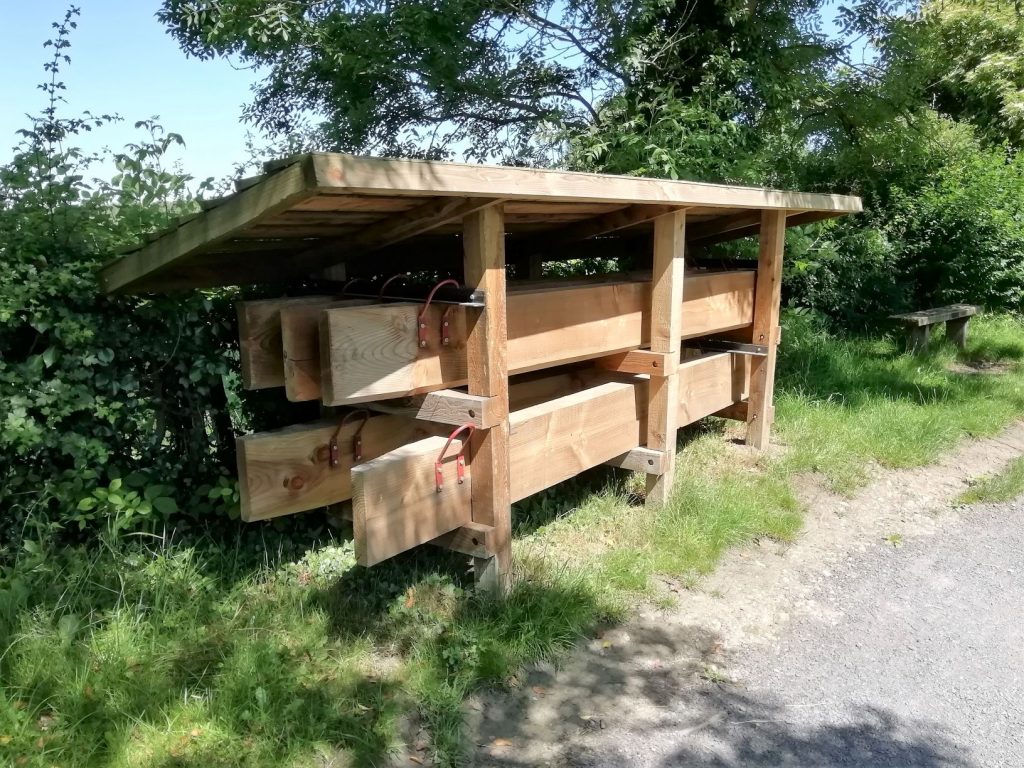
On this Thursday afternoon we stopped on the aqueduct crossing back over the Trent & Mersey as we had a parcel to collect from the Post Office in Kidsgrove and would also pass a large Tesco on the way there. Urgent supplies were needed, notably Sue’s wine. In the brief view we had of it Kidsgrove seemed a very ordinary place dedicated to the canal and the railway in its hey-day and now, although busy, a bit lost.
We didn’t linger long and carried on to Hall Green Stop Lock where the true Macclesfield Canal begins. There is no real need for a lock here. It exists purely to satisfy the paranoia of the established Trent & Mersey company that the Macclesfield interlopers might take advantage in some way. It is only a 1′ 4″ rise on to the new cut, it is actually hard to tell by eye whether you are heading up or down. Originally, apparently, there was a pair of stop locks here, each with an accompanying lockkeepers cottage and stable block. It became something of a Checkpoint Charlie with employees of the two companies housed on either side, glaring at one another in mutual mistrust. Their antipathy was only perpetuated when each was taken over by a different railway company during the canal’s decline.
Little Moreton Hall & Congleton
On the way back up to the boat we had discussed how useful it would be to draw up a plan that mapped out where we expected to be, on what day and what services would be available at what points etc. We had concluded with a solid agreement that someone definitely ought to do that.
While waiting to see if the rain would stop on Thursday morning we had put something together for the next week or so. We stopped, as planned, at Bridge 68, a very pleasant, remote mooring site with nothing to distinguish it, not even a name. The one key feature here was a footpath running down from there directly to Little Moreton Hall, a National Trust property we had thought we would visit this afternoon, combined with a longer walk. We would then stay over a second night and move on to Congleton on Saturday morning.
Naturally, life intervened. Bracken had just stopped eating on Wednesday evening, then began vomiting and had now developed diarrhoea. As we had discovered over breakfast that it was now Friday we thought we should see a vet today, rather than having to wait until after the weekend. That would also mean moving on to Congleton today rather than tomorrow.
The sun was shining and having rung to secure an appointment with a vet in Congleton for four fifteen, we had time to walk down to Little Moreton Hall and have a quick look this morning, before we left. The hall was a moated manor house, quite interesting to look at, a real crooked house. It was hard to tell if any given feature was built that way or was sagging under its own weight. It seems it is particularly well preserved simply because a reversal in fortune of the family that owned it meant that they didn’t have the money to make the kind of modifications to keep up with fashions over the years that would have changed its character. Sadly, dogs were not allowed to cross the moat, a draconian policy that meant we didn’t have time to explore inside, going in one at a time. We couldn’t even take advantage of the café.
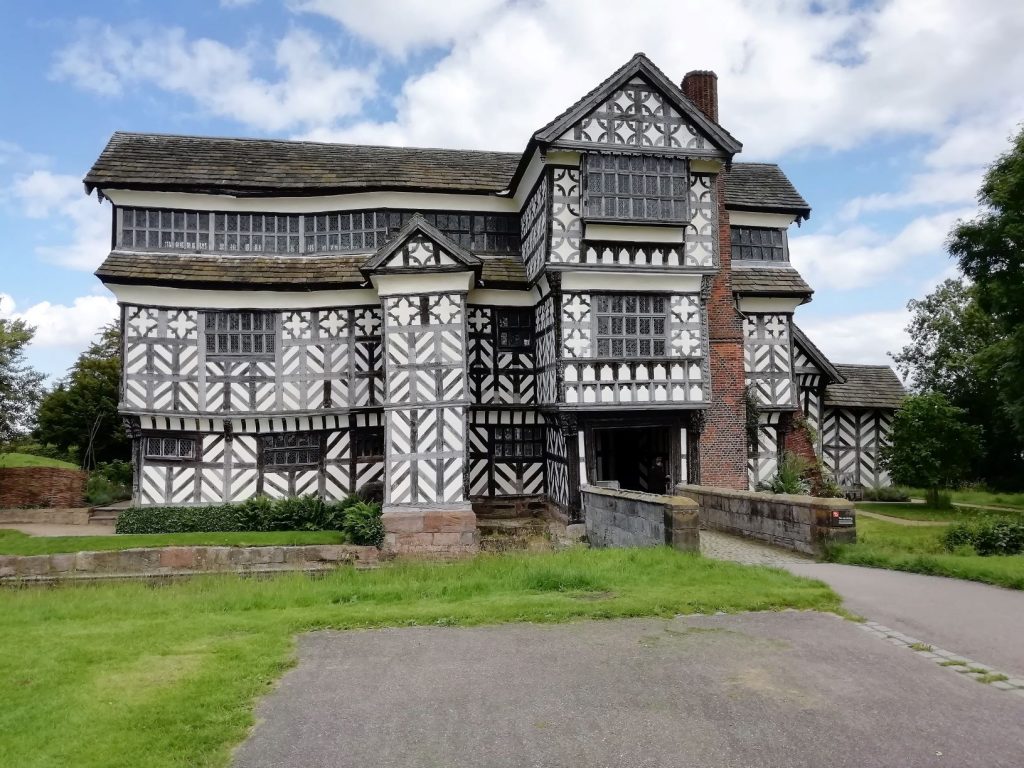
Returning back up the footpath we set off for Congleton, three miles up the cut with no obstacles in the way. We managed to get the last mooring by the Canal Road Aqueduct with sunshine on the boat and the solar panels well into the evening of this, the longest day. A nice spot and an ideal place to get down into the town for the vets and have a look around..
The town centre is ten minute walk from the canal and is best described as tidy. It is fairly compact, has a pedestrianised main street with the usual amenities. There were not many of the high street chains represented, although, of course, they had a Costa. They had plenty of charity shops but it managed to avoid feeling too run down and there seemed to be quite a few nice restaurants and bars as well.
The vet was reassuringly expensive, although a lot cheaper than ours at home, never mind the animal bandits in London. A consultation with a shot to stop the vomiting, instructions for a diet of chicken & rice with some stuff to put in her food for the next few days and we were on our way.
There was time for a stroll around our mooring site just by the aqueduct. It was a pleasant wide area in the sunshine and the towpath led down to a nice changeover bridge with a bridle path running across it.
Exploring just a few yards up the bridle path above the bridge we came across clear evidence that, despite sitting alongside reminders of the leisurely communications of the past, Congleton is ready and willing to embrace the 21st Century, right on its doorstep!
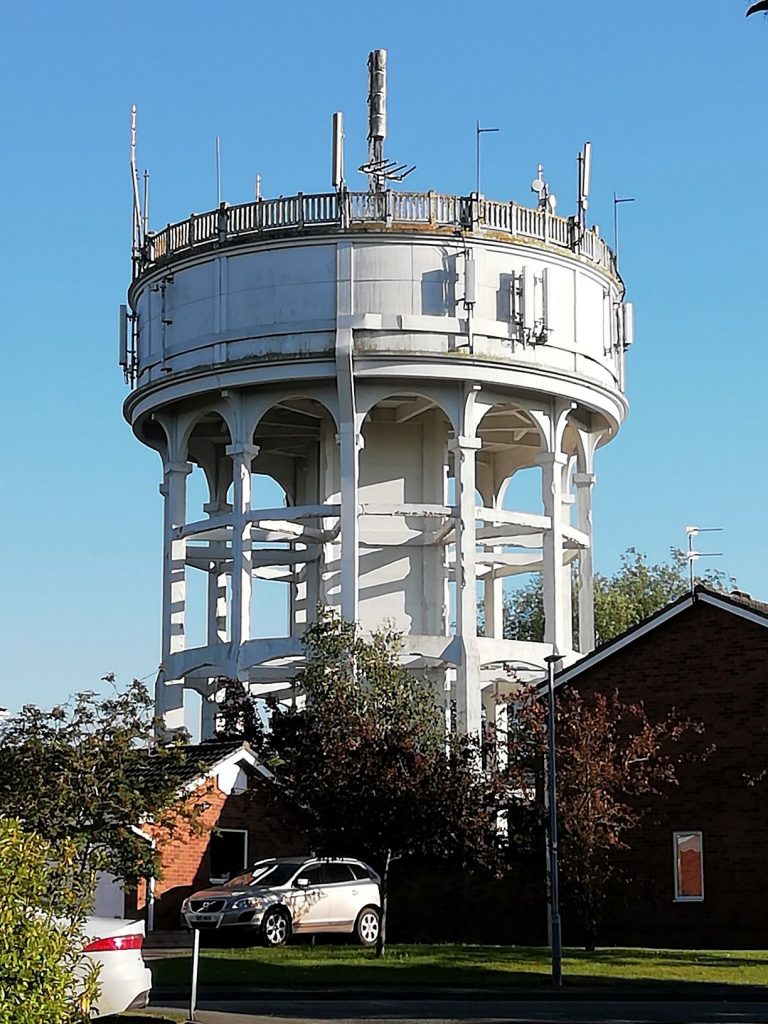
The Longest Day
Well, technically, the longest day was on Friday but by the end, this sunny Saturday this felt like a very long one to us. We planned to move up to just short of Macclesfield and then go into the town the next day. It was about eight and half miles but also involved the twelve locks of the Bosley flight, a couple of swing bridges and, as it turned out, an element of trauma.
The first lock leads to a very sharp left hand turn to get into the second. I can’t imagine anything longer than fifty foot being able to make it in one, so there was a certain amount of backing and filling in the pound to get us lined up. Having got through that one we could start to try and get into more of a rhythm for the straighter run up the rest of the flight, with Sue going ahead to start the next lock while the one I was in was filling and then coming back to close the gates. While waiting, I tried to work out any way I could help closing the paddles and opening the gates once the lock was full.
Even at my age my capacity for stupidity and clumsiness can still surprise me. I was distracted by looking at the set-up of the locks and thinking about how to work them most efficiently, instead of focussing entirely on what I was doing. After many years of repeatedly reminding myself that the one thing I mustn’t do is let my fingers get caught in the lock mechanism, I let my fingers get caught in the lock mechanism. It happened so quickly that I still don’t quite know how it did come about but the crushed digit bleeding onto the towpath told the story. It was only one thumb and the left one at that but the pain was as intense as bashing your thumb while banging in a nail. Over the next few days I was given repeated reminders of why having two, fully operational, opposing thumbs was so critical to the development of human civilisation. Whilst effecting some running repairs we reflected on the irony that, only yesterday, we had walked past Congleton’s minor injuries unit, handily situated a few hundred yards from the canal and had even congratulated ourselves on not having needed such a facility thus far.
Ready to carry on we got back to work, sliding into the fifth lock of the day we started it filling, rose to the top, opened the gates and engaged forward gear to move slowly into the pound. Nothing happened, in itself a very odd sensation. A bit more throttle, still nothing. Eventually came the realisation. The top of the lock must be narrower than the bottom and the power of the tons of water entering the lock had forced our six foot ten inch hull up between the four inch thick rope fenders on each side and firmly wedged us in the lock chamber. On closer examination we could see that one of the fenders had been torn off altogether and was missing. The only solution was to let some of the water out, very slowly, allow the weight of the boat to take us back down to where the walls were slightly farther apart, lift the fenders out of the way and then refill the lock. Simple but time-consuming.
By the time we had completed the flight and moored on the service dock at the top it was already three o’clock and the sun had been fully out and beating down for several hours. While we were taking on water we chatted to a guy who was single-handed and was waiting for a friend to join him and help him down the locks. Despite his obvious experience he did not regard it this flight as really being feasible to negotiate alone. We told him where we planned to moor and he offered a better, more open spot which might be nicer. It is always worth listening to local knowledge so, even though it would add a little more distance, we decided to take his advice.
As we moved on through the electronic Royal Oak swing bridge, which is where we had planned to stop, we could see what he meant as it was deep and dark in the woods and would be a shame to bury ourselves there on a rare sunny evening. The site he had recommended was only a mile or so farther on and bathed in sunshine along the axis of the canal, so we would have sun in the evening and in the morning, if there was any.
Having moored up and looked at the map we realised we were only a bridge or so away from a pub called Sutton Hall, highly recommended by Lesley Fielding when we saw her the other day. It was a lovely evening for a walk and this would be a chance to exercise Bracken. It felt like we had had quite a day and deserved a treat and something to ease my throbbing thumb so we made our way down to the pub. It is a great place. Perhaps it once really was a squire’s hall? It certainly had extensive grounds, its own carriage drive and a lot of interesting connected spaces inside. As luck would have it, however, we had arrived on the day on which it was acting as one of the checkpoints for the annual Sutton Eight charity walk. As such, it was absolutely packed and at seven o’clock had clearly been under siege for many hours. The barmaid told us she had started her shift at nine that morning and all the staff looked a little frazzled. The garden was occupied by groups of middle aged men in fishnet stockings or turquoise lycra and pink leggings, so we think the Sutton Eight may have been a fancy dress affair with an eighties theme. If they were at point seven in an eight point walk they showed no sign of moving on. At this time of year, however, they had plenty of daylight left to burn so perhaps they would eventually.
Getting a drink didn’t prove too difficult but food was already up to a forty minute wait from when you ordered, with more people arriving all the time, so we didn’t eat there on this occasion. It was lovely just sitting in the garden in the sunshine at eight o’clock in the evening, though, so we had another drink and then set off back to the boat. On the way you could just see the beacon of a Burger King sign a short walk down the road from our nearest bridge. Every now and then it is quite nice to indulge in a guilty pleasure after a particularly trying day. It was too late to want to start cooking now, anyway, so we gave in to our basest instincts and I went to play the hunter / gatherer and Sue returned to the boat to put the kettle on.
Macclesfield Town
On Sunday we intended to move up to the town moorings at Macclesfield. Having heard good things we thought we might stop here for two nights and explore a bit more. There is a three day mooring site marked on the map, which is where we were headed, the only thing was that they were at the far side of the town with nowhere flagged as suitable to moor once you were past them. It turned out that there was only space for four to five boats on a jetty made up of scaffolding poles with a kink in the middle. At the time we arrived, they were full. Just beyond the next bridge we found a section of repaired bank with nice new Armco to tie up to. We soon found out why no-one else was there. Below the surface the bank was lined with huge stones and you couldn’t get the boat alongside. We didn’t have much option, though, so it was a chance to unship the gangplank and use that to bridge the four foot gap to the shore. It seemed quite workable on a warm afternoon although not entirely comfortable.
With large parts of the country under threat of thunder storms and flash flooding one thing we weren’t prepared for was the gale that gradually blew up over the course of the evening, rocking the boat and shifting the vital gangplank around. At that point, however, even if our position felt a little exposed now, any attempt to move to a different site further on would only make matters worse. In the end, the wind blew through, a smattering of rain died out overnight and we never saw a flash of lightning or heard a clap of thunder, never mind experienced the threatened deluge.
During Sunday afternoon we had had a brief foray to the local park and of course the nearest supermarket. In our original plan, as we had been told that Monday would be a mostly rainy day, we had thought we would look around Macclesfield on Monday and stay on there another night. By Sunday evening we decided we would rather only stay rocking on the gangplank for one night but at the same time we were also advised that the weather on Monday would not be that bad after all. Accordingly, having survived the night without harm, we decided to have a look round during the morning and move on later in the afternoon.
We set out into the town on Monday morning, via a run in the park for Bracken, heading downhill from the canal to the ring roads and the station. First impressions were not that favourable, with the area we walked through reminding both of us quite a lot of Croydon old town and the flyover there – not a recommendation.
The market place is really the centre and sits on the top of a steep hill. The rest of the town seems to have developed around it, flowing down the sides as time went on. It is a steep climb up narrow cobbled streets to get to the top but once you emerge on the summit it creates a much more favourable impression. We picked up a free heritage trail from a very helpful Tourist Information office and followed its directions around forty four points of interest. You only ever take in a proportion of these things but they do help you to get a feel for a place and ensure that you cover the areas you might not have thought to visit. It was interesting to see the way the growth of the silk and button trade had fostered the town’s development and it became very evident that most of the town’s prominent citizens and owners of the grander houses had essentially been part of the legal profession.
The current modern town is pedestrianised for a good part of the summit and sports all the surviving high street names you can think of. There are still smaller independent traders of all kinds to be found in the surrounding streets and a plentiful supply of pubs and restaurants. The overall feel is of a safe, clean and prosperous town. The people are very friendly. We found ourselves engaged in conversation with passing locals a number of times, often initially attracted by Bracken, who will talk to anyone. One lady, who had seen us studying our guide at the side of the road, even stopped her car to ask if we needed any directions, which seemed very kind.
We left the centre with a much kinder view of Macclesfield than we had had when we arrived there and headed back down the steep mound to cross the valley bottom by the station and climb back up to the canal.
Bollington
Our next port of call was Bollington, only two or three miles further on and as we arrived at the moorings there the sun had started to break through. We were in time to find the recreation ground and the adjacent pub called The Vale. It was nice to sit outside with the late sun shining on their new decking overlooking the cricket clubs nets practice. A nice pub with friendly staff, featuring beers brewed in their own Bollington brewery across the street, the one oddity is that the only way to get from the bar to the terrace is to leave the pub, walk past a handful of unrelated cottages and then through the pub car park at the end of the street,
Bracken seemed perfectly fine in herself and had certainly stopped the vomiting following her injection on Friday. Nonetheless, her diarrhoea just didn’t seem to be clearing up. There was a large board on the towpath, just beyond where we had tied up, advertising Bollington Veterinary Practice. At the same time we were now expecting a wet Tuesday. Since we had left Macclesfield earlier than planned and arrived here only in the afternoon we chose to stay an extra night in Bollington, pay another visit to the vet and spend Tuesday exploring there.
Our Pearson’s Guide says: “. . . Bollington is as spick and span and as pretty as any hill town in Umbria”, so it sounded very promising, although I do wonder if that was a misprint for Cumbria. From the perspective of the canal traveller the town is bounded by two huge cotton mills, one at each end, known as Adelphi Mill and Clarence Mill. Neither are operating as mills any more but are presumably protected and trying to attract modern businesses to use the space for offices and the like. Despite the scale of these buildings they don’t really dominate the whole area as much as you might expect.
The towpath is used a lot by dog walkers, runners and cyclists and there are footpaths all around the town that take advantage of the woods and fields to avoid the main streets. The canal follows a contour on steep hillsides and is carried by a high embankment and an aqueduct across the road that seems to connect the two sides of Bollington. To the west, below the canal, the road drops away and then runs through a section that seems residential and commercial, keeping itself at a respectful distance and height from the River Dean in the bottom of the valley, which seems to have supported the original water driven mill industry. The new Co-op supermarket is here, surrounded by estates of red brick houses from the eighties and newer developments using materials more in keeping with the original properties. These seem to have been built between the road and the river. Presumably they are built on the sites of some of the old mill buildings with centuries of experience that says they won’t flood. The main road continues to the east and climbs steeply from the valley where it passes under the canal through the area with most of the pubs and amenities in it, towards the moors and peaks beyond. Strangely, the most famous landmark high above the town, known as White Nancy, can seldom be seen from its streets as there always seems to be the shoulder of a hill, an ancient tree or a fine old church building blocking the view. Being white, it also easily disappears into the overall cloudscape on a grey day.
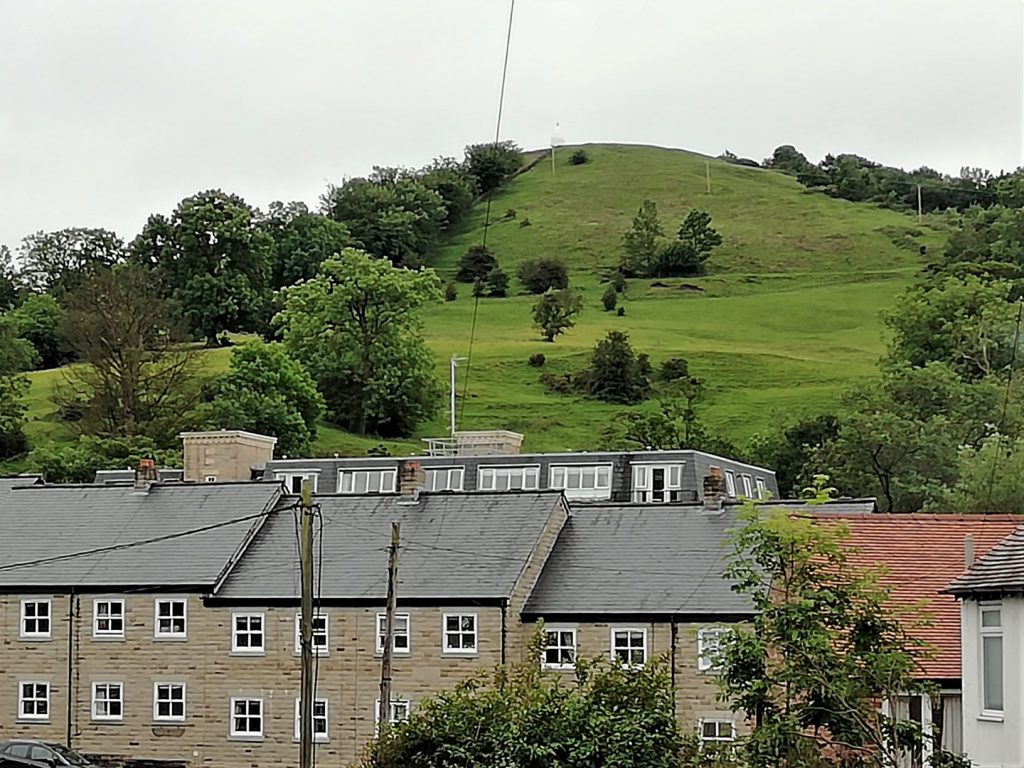
Overall, we liked Bollington. It is bigger than it first appears, has a lot of character and is clearly well-loved and looked after but also has all the amenities you could need, from Indian Restaurants to canal-side cafes and its own Community Radio Station. It seemed busy and prosperous and although it is likely most of its residents are commuters these days, there were a lot of social activities in evidence from canoeing to art classes taking place in the street. In terms of negatives, the main road through the town is horribly busy, with narrow pavements and few crossing places and then there is the simple fact that everywhere you go it is so damned steep!
Up The Junction
On Wednesday it was time to move on, although not too far. As we had been moored immediately opposite Bollington Wharf it was, theoretically, a very simple matter to move across the canal in order to take on diesel and water and empty our various wastes. In classic style, we had just untied the first mooring line as a boat came past and asked if we knew whether he could get water there. We could hardly stop him calling in there so we had to tie back up and wait a while. He didn’t take too long though and we were able to try again, with more success, just twenty minutes later. We even bought a new rope fender to replace the one lost back at Bosley Locks.
Higher Poynton was only chosen as a staging post where we could stay the night before the final assault on Marple Junction. We tied up a little before Bridge 15, which turned out to be a centre of activity. Beyond the bridge lay a long stretch of mooring on the off side that seems to be operated by Bradbair Boats, who also have the boatyard by the bridge. There is Bailey’s Trading Centre by the bridge and a tea room as well as the Boar’s Head. The Middlewood Way, based on the disused railway runs right through between the canal and the pub and has been developed into a really nice picnic area and cycle trail and there is a wide network of footpaths and bridleways covering the area, including a route to the Lyme Park National Trust site to the east. The village itself lies a little way further west, beyond the pub but details of the various businesses and amenities are clearly displayed around the towpath and in the car park there. This has a small Visitor Centre with displays on the history of Nelson Pit. They make interesting reading as you compare the bucolic village sitting in the sun outside with the work and conditions described on the display boards. Nelson Pit was just one of many small collieries owned by the Lords of Vernon that dotted the area in the not so distant past. They closed in about 1935.
It all made for a nice walk, an interesting afternoon and a very pleasant overnight stay, we could have stayed longer and visited Lyme Park but in the end we decided to press on. Our plan said we should take on water at the bridge and then stop at Marple on Thursday night. However, we had also decided that we would actually go beyond Marple on Thursday and moor a little further up the Peak Forest Canal. Accordingly, we bypassed the water point at Bridge 15 as we knew that we would be stopping at the services just before the junction.
Never pass up the opportunity to fill or empty your tanks should be every boater’s motto. It was a very pleasant run down to Marple, just a few miles in warm sunshine. Marple on the map looks quite a big place. As you are approaching on the canal you can see the big mill that would have marked its outer limits and I assumed we were about to enter a longish stretch of built up area and derelict industry. However, around and opposite this building there is also a large, well maintained golf course. In fact, the canal appears to skirt the eastern edge of the main town and then turn down its northern side. so for us, although there were some big buildings to pass through, it didn’t seem much more urban than Bollington.
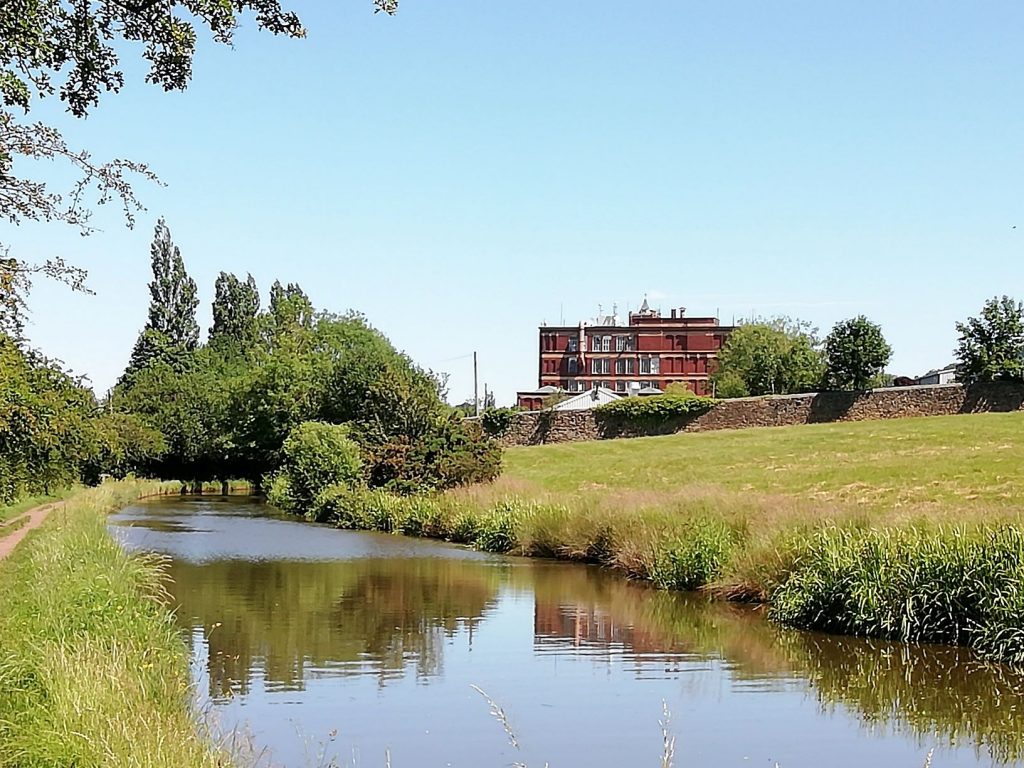
As we approached the last bridge we passed a boat going in the other direction. He informed us that if we wanted water there were four boats in the queue already and it was taking an hour and a half to fill each boat due to the low pressure. We had passed up water this morning, we needed water today but if we waited six hours to get it we would not be moving on to find a mooring until about seven o’clock tonight. When we arrived at the service dock there were indeed lots of boats queuing and they confirmed what had been said. The people currently at the water point had moored overnight and been waiting all morning.
We decided we would not get water here but would use the other services so as we asked the boat that was already filling if we could moor alongside. They were fine with it so I started reversing the boat as best I could, mainly looking to stern. As we came alongside Sue stepped onto their gunwale with our centre line to secure us to their handrail. I was still looking backwards but when I heard a strange noise I turned to ask Sue what was happening, only to find that she wasn’t there! She had fallen in the water, hence the noise.
It is never as easy getting someone out as you think and we were probably lucky that so many people were on hand to help although, as always, that did entail a lot of loudly shouted, contradictory advice and instructions. I am pleased to report that when she was retrieved Sue was still clutching our centre line! Heaven forfend that she might have allowed the to drift off into the canal unmanned. That might have given us a real problem ;-).
All in all we were quite lucky. It was a warm day and even the water wasn’t cold. She bruised her shoulder on the way down but no other injuries and she avoided being crushed between the two hulls. With all the boats queued up at the water point she was also lucky enough to have a captive audience for the whole episode, who will no doubt dine out on the incident for years.
Having recovered a little from the shock Sue went below to have a shower, I finished our business at the services and we moved on through the junction to leave the Macclesfield Canal behind us. Despite the experience of the last half hour we left with a very positive view of the week we had spent on the Maccie and Sue can now call herself a real boater at last. Having had this trip through we know a bit more about where we might want to stop, for how long and what there is to see around it so I think we will certainly do it again sometime.

